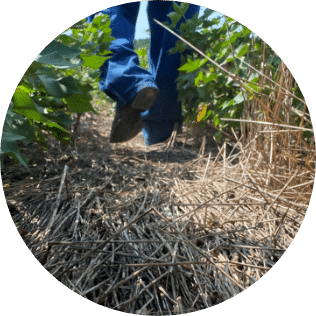

These include an effort to reduce greenhouse gas (GHG) emissions by 39% and increase soil carbon by 30% in the 10 years between 2015 and 2025 While these are aggressive goals, we think they are possible. In the U.S., cotton has seen a 25% reduction in greenhouse gas emissions since 1980.2 How? Cotton growers today use more efficient irrigation systems and use crop inputs more efficiently while increasing the amount of cotton produced per acre.

Making polyester fiber emits 3 times more greenhouse gases than cotton. Making nylon fiber takes nearly 5 times more greenhouse gases compared to cotton.3

If conservation tillage practices were adopted by just 20% of cotton growers globally, this shift alone would sequester 3.9 million tons of carbon per year in the soil – the same as taking more than 700,000 cars off the road for a year.4
Emissions
Emissions from cotton production are declining thanks to new technologies. The U.S. Cotton community has set goals to reduce GHG emissions by 39 percent by 2025, which is in line with the Paris Climate Agreement.

THE LATEST

From Seed to Finish: Cottonseed Oil Powers Safer, PFAS-Free Textile...
Why it matters: PFAS and formaldehyde restrictions are tightening; brands need safer, high-performance finishes that scale—and a credible circularity story. Driving the news: Cottonseed oil is emerging as a bio-based platform for formaldehyde-free wrinkle resistance...
As Plastic Pollution Persists, Cotton Fiber Offers a Biodegradable Solution
The Global Challenge: The global conversation remains active—as the issue persists and new research continues to emerge, attention is expanding to include the full lifecycle of materials, especially synthetic textiles. As a result, the need for alternatives to...
The Journey of Our Textiles
Discover how cotton naturally biodegrades, returning to the earth—unlike synthetic fibers that persist in the environment.
- U.S. Cotton Trust Protocol. (2021). Measures and verifies sustainability commitments. https://trustuscotton.org/about/powered-by-data/.
- Field to Market: The Alliance for Sustainable Agriculture, 2021. Environmental Outcomes from On-Farm Agricultural Production in the United States (Fourth Edition). ISBN: 978-0-578-33372-4. https://fieldtomarket.org/national-indicators-report/
- Moazzem, S., Crossin, E., Daver, F., & Wang, L. (2018). Baseline Scenario of Carbon Footprint of Polyester T-Shirt. Journal of Fiber Bioengineering and Informatics, 11(1), 1–14. http://journal10.magtechjournal.com/Jwk_JoFBaI/EN/Y2018/V11/I1/1.
- Cotton Incorporated (2021). Monthly Economic Letter: Cotton Market Fundamentals & Price Outlook, February 2021; Franzluebbers, A. J. (2010). Achieving Soil Organic Carbon Sequestration with Conservation Agricultural Systems in the Southeastern United States. Soil Science Society of America Journal, 74(2), 347–357. https://doi.org/10.2136/sssaj2009.0079.
- Causarano, H. J., A. J. Franzluebbers, D. W. Reeves, and J. N. Shaw. (2006). Soil Organic Carbon Sequestration in Cotton Production Systems of the Southeastern United States: A Review. J. Environ. Qual. 35:1374-1383.

